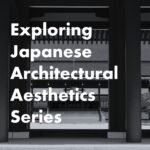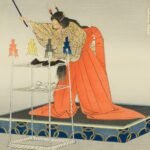When discussing Japanese architectural aesthetics, we often attribute special value to the concept of “wa” (harmony). The solemn presence of Ise Shrine, the refined spatial composition of Katsura Imperial Villa, and the wabi-sabi spirit dwelling in tea rooms—these are often revered as “crystallizations of Japanese-ness,” celebrated as eternal, unchanging beauties that have dominated mainstream discourse on Japanese architecture.
However, Kengo Kuma, often labeled as a “master of Japanese-style architecture,” poses a sharp question to this fixed view of Japanese architectural aesthetics in the preface of his book “Japanese Architecture” (Iwanami Shinsho):
“Japanese architecture is a mirror that continuously reflects our everyday lives in various ways.”
Kengo Kuma, “Japanese Architecture,” Iwanami Shinsho
This statement embodies a perspective that reconsiders Japanese architecture not as a “corpse” but as a “living entity.” In this article, we’ll explore Kuma’s provocative thesis to reconsider the meaning of “wa” in contemporary times and examine Japanese architectural aesthetics as a living tradition.
Discomfort with the Label “Master of Japanese-Style Architecture”
Kengo Kuma expresses strong discomfort with being called a “master of Japanese-style architecture.” For him, “wa” is not an immutable style fixed in the past but rather something like a living organism that constantly evolves with the times and social conditions.
The title “master” suggests a form of completion, an arrival point. However, in Kuma’s architectural philosophy, Japanese architecture represents an ongoing “question” that never reaches completion. This reflects his stance not as a “guardian of tradition” but as an architect who maintains a continuous dialogue with tradition.
This humility and critical spirit are, paradoxically, what establish Kuma as an important thinker in contemporary Japanese architecture.
Japanese Architecture as a “Mirror”
Kuma’s metaphor of the “mirror” offers rich insights into understanding the essence of Japanese architectural aesthetics. A mirror reflects objects as they are, yet forms different images depending on the viewing angle and lighting conditions.
“Japanese architecture is a mirror that continuously reflects our everyday lives in various ways. That is, when we focus on how architects have perceived and expressed Japanese architecture, the characteristics of that era and the position of that architect become clearly visible. … By doing so, I felt Japanese architecture emerging as a kind of living organism. Being a living organism means rediscovering Japanese architecture as a social, political, and economic entity.”
Kengo Kuma, “Japanese Architecture,” Iwanami Shinsho
Similarly, Japanese architecture “appears in completely different forms and faces depending on which era and position it is viewed from.” For example, architects of the Meiji period sought “Japanese-ness” while incorporating Western techniques, while post-war architects pursued new expressions of “wa” amid tensions between tradition and modernization.
Tracing how architects of different eras perceived and expressed Japanese architecture also leads to understanding the social, political, and economic contexts of those times. Thus, discourse on Japanese architectural aesthetics is not merely a history of styles and techniques but also a “discourse on Japan” that reflects the evolution of Japanese identity and values.
The Contrast Between “Corpse” and “Living Entity”
Perhaps the most provocative aspect of Kuma’s argument is the dichotomy between treating Japanese architecture as a “corpse” versus a “living entity.”
Japanese architecture as a “corpse” refers to the attitude of idealizing specific eras or styles and treating their forms as absolute. It means constructing a “sacred lineage” from Ise Shrine → Katsura Imperial Villa → Tai-an tea house and worshipping it as “orthodox Japanese architecture.” Such a view fixes Japanese architecture like a museum exhibit, closing off living dialogue with the contemporary world.
For Western readers unfamiliar with these references:
- Ise Shrine is Japan’s most sacred Shinto shrine, rebuilt every 20 years for over a millennium
- Katsura Imperial Villa is considered a masterpiece of Japanese architecture from the 17th century
- Tai-an is a tiny, acclaimed tea room designed by the tea master Sen no Rikyū in the 16th century
Conversely, Japanese architecture as a “living entity” means viewing it as an organism that continuously changes within social, political, and economic contexts. It focuses not on specific “forms” but on more essential “ideas” or “sensibilities” such as dialogue with environment and materials, use of space, and relationships between light and shadow.
For instance, the simplicity of tea rooms or the rationality of traditional houses are not merely stylistic features but manifestations of Japanese thought patterns—coexistence with nature and ingenuity within material constraints. Reinterpreting these essences in contemporary contexts is the path to inheriting Japanese architectural aesthetics as a “living entity.”
Japanese Architectural History as “Multiple Lines”
Kuma further emphasizes the importance of reading Japanese architectural history as “multiple lines” rather than a “single line.”
Since the Meiji period, as part of constructing Japan’s identity as a “nation-state,” Japanese architectural history has been intentionally linearized. However, in reality, various architectural perspectives have coexisted, sometimes conflicting and sometimes merging.
For example, post-war architects like Togo Murano, Seiichi Shirai, and Kenzo Tange each pursued “Japanese-ness” in different ways. Murano found the essence of “wa” in material textures and delicate details, Shirai in the aesthetics of “poverty,” and Tange in modern interpretations of traditional spatial compositions.
By considering these diverse interpretations in parallel, we can see the rich possibilities of Japanese architectural aesthetics. In Kuma’s words, by reading Japanese architecture as “multiple lines,” we can “faintly arrive at the future of Japanese architecture.”
Regeneration of “Wa” in Contemporary Society
Contemporary society is changing at unprecedented speed with globalization, climate change, pandemics, and development of digital technology. What does it mean to pursue the architectural aesthetics of “wa” in such circumstances?
From Kuma’s perspective, it means not imitating past styles but reinterpreting the essential values of Japanese architecture in contemporary contexts. For example, the use of natural materials, harmony with the environment, and flexible, multifaceted spatial compositions—principles underlying Japanese architectural aesthetics—are beginning to take on new significance in contemporary society, which demands sustainability and diversity.
In Kuma’s recent works, we can see elements that interpret the essence of Japanese architectural aesthetics in contemporary ways—his philosophy of “weak architecture” using local materials like wood, and techniques that blur boundaries between nature and architecture. These are not simply “Japanese-style” aesthetics but truly “living” architecture born from relationships with environment and society.
Conclusion: Japanese Architectural Aesthetics as a Living Tradition
Kengo Kuma’s challenge teaches us the importance of reconsidering Japanese architecture not as a fixed “corpse” but as a “living entity.” This is not about denying past heritage but rather about actively bringing the essential values of tradition to life in the present and passing them on to the future.
The beauty of Japanese architectural aesthetics may not lie in specific forms or styles but in the “aesthetics of relationships” born from dialogue with environments, materials, and human activities. And these relationships continue to change with the times.
Exploring “wa” is not about seeking fixed answers but about continuously questioning. In Kuma’s words, “Japanese architecture is a mirror that continuously reflects our everyday lives in various ways,” and what this mirror reflects is not only the image of the past but also our own present selves.
The exploration of Japanese architectural aesthetics is a journey not only to the past but also to the present and future.
This article is the second installment in our exploration of Kengo Kuma’s “Japanese Architecture” (Nihon no Kenchiku), which itself forms part of the broader Exploring Japanese Architectural Aesthetics series.
- Explore the complete Exploring Japanese Architectural Aesthetics series
- Discover all articles on Kengo Kuma’s “Japanese Architecture” within this series
If these ideas resonate with you, I warmly invite you to explore the entire collection.
While Kuma’s book is written in Japanese, it’s available in Kindle format through Amazon for those interested in diving deeper into his original insights. You can find it here (this is not an affiliate link).
Note: Please note that when no official English translation of a quoted passage exists, the translation provided has been created with the assistance of artificial intelligence.



